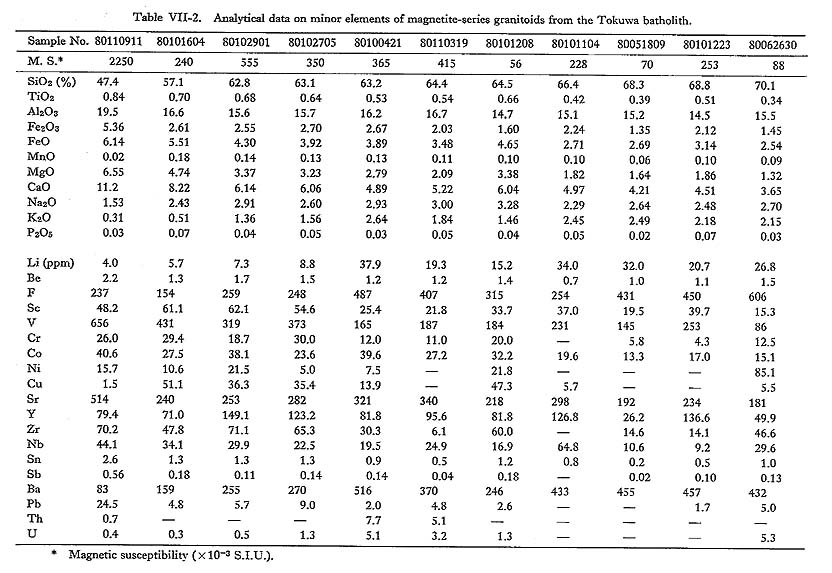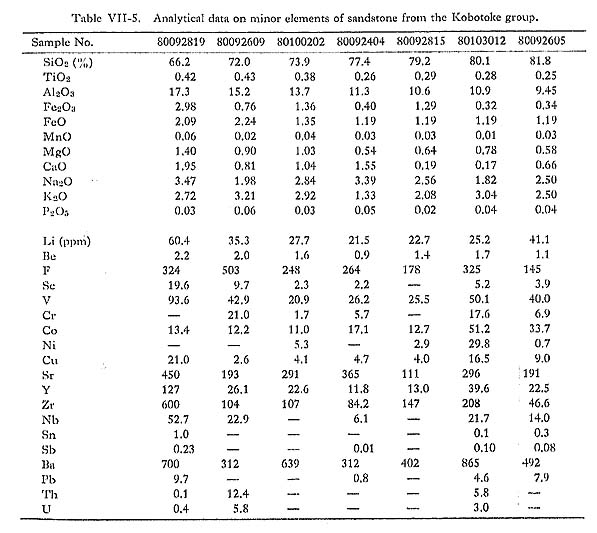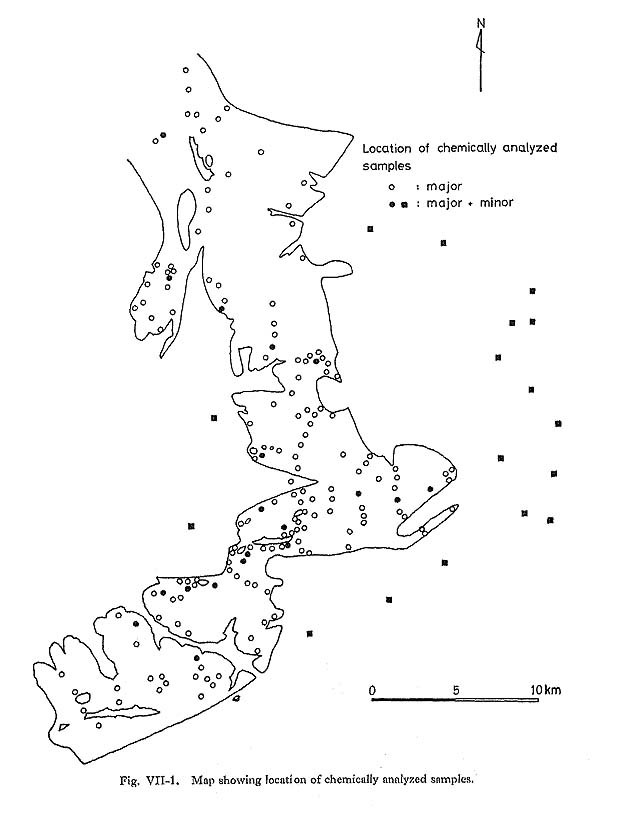CHAPTER VII
Whole-Rock Chemistry
2) Minor Elements
|
Twenty-two representative samples from the Tokuwa batholith and 17 sedimentary rocks from the Kobotoke Group were analyzed with argon-supported inductively-coupled plasma atomic emission spectromctry (ICP/AES) for their minor elements. One hundred mg of sample powder was digested by a mixture of 3 ml of perchloric acid, 6 ml of hydro fluoric acid, and 2 to 3 ml of tri-distilled water. The solutions thus obtained were diluted to 100 ml. Provided that the effect of the acidity of the sample solution does not vary from one sample to another, blank solution, standard solutions of JG-1, JA-1, JB-1, and JB-2 (furnished by the Geological Survey of Japan), and standard solutions of Al, Na, K, Ca, and Fe were atomized in the apparatus to establish calibration data for analyses. The blank and sample solutions were passed alternatively in the apparatus to obtain background correction factors. Each analysis was repeated three times for each solution. The error of the determination for each element is estimated to be several % (Notsu, 1980). The analytical results are shown in Tables VII-2 to VII-5, and are plotted against the SiO2 contents in Fig. VII-14. Locations of samples analyzed are shown in Fig. VII-1.
As is clear in Fig. VII-14, no significant concentration differences between the two series of rocks were observed except for elements F, Li, Sc, V, and Sb. The characteristic features of the minor elements of the Tokuwa batholith rocks were clarified by ICP analysis as follows: (1) Be, Sc, V, Cr, Co, Sr, Cd, Sn, Sb, Pt, and Pb decrease progressively from hornblende gabbro to biotite granite. (2) The behaviors of Ni, Cu, Y, Zr, Nb, La, Eu, W, and Au is rather erratic with respect to the variation of SiO2 contents. (3) Li, F, Ba, Th, and U increase progressively with the increase in SiO2 contents. Ishihara and Terashima (1977) reported that ilmenite-series granitoids of the Naegi and Ryoke Belts are rich in F, Rb, Li, Sn, and Be and that these elements increase with the increase in the SiO2 content, whereas magnetite-series granitoids of the Shirakawa Belt are poor in these elements and their contents are nearly constant. Beryllium contents in ilmenite-series granitoids of the Tokuwa batholith are slightly higher than those in typical magnetite-series granitoids, whereas Sn contents of ilmenite-series granitoids are slightly lower than those in typical magnetite-series granitoids (Fig. VII-14). In these two cases, the points for ilmenite-series rocks in the figure lie between those of magnetite-series rocks and country rocks. It can be generally stated that ilmenite-series granitoids of the Tokuwa batholith are compositionally related to sedimentary rocks. Ilmenite-series rocks show an affinity with country rocks: if the country rocks are enriched in a given element, then the ilmenite-series granitoids are expected to be enriched. It is confirmed that the ilmenite series granitoids of the batholith are enriched in such Hthophilic elements as Li, F, Ba, Th, and U, which are also rich in sedimentary rocks of the Kobotoke Group. Therefore, the contribution of country rocks to granitoid genesis can be estimated. A small concentration gap between sedimentary rocks and magnetite-series granitoids found for Sc, V, Ba, F, Li, and Y might also indicate the possibility of magmatic assimilation with sedimentary rocks, as does the Ba/Sr ratio in the K2O content diagram (Fig. VII-15).
|







